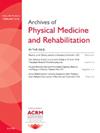Gait Training with Robotic Exoskeleton: A Case Report on the Treatment of Neurological Patients with Ataxia
IF 3.6
2区 医学
Q1 REHABILITATION
Archives of physical medicine and rehabilitation
Pub Date : 2025-04-01
DOI:10.1016/j.apmr.2025.01.069
引用次数: 0
Abstract
Objectives
To assess treatment of gait instability in the subacute and chronic phase after a cerebral infarction as well as chronic brain injury after tumor removal, by focusing on postural impairment and gait ataxia, with the use of robotic overground ambulation. Treatments such as virtual reality, biofeedback, and postural stability training have shown some promise to treat ataxia, but specific efficacy needs to be further investigated (Marquer, 2014). Santos et al looked at therapist-assisted gait training versus bodyweight supported robotic-assisted gait training, which concluded that one was not better than the other (Santos 2018). No current studies have looked at the efficacy of robotic-assisted overground gait training without body weight support when not done in the intensive (5d/wk) setting.
Design
This is a 2-subject qualitative case study. There was no follow-up after discharge.
Setting
Outpatient neurological physical therapy.
Participants
Two patients with subacute cerebral infarction and chronic brain injury participated in this observational study.
Interventions
Both patients participated in outpatient neurological physical therapy. Over the span of 12 weeks, patients underwent an Ekso training program that included 10 sessions walking with decreasing assistance levels followed by overground ambulation between 100 and 200 feet each session.
Main Outcome Measures
Ataxia deficits were quantified by ataxia scores on the scale for the assessment and rating of ataxia (SARA), performed at every 8th to 10th visit. Standing balance and gait were also assessed through the Berg Balance Scale (BBS), Six-Minute Walk Test (6MWT), and the Ten Meter Walk Test (10MWT).
Results
In the subacute and chronic phase, patients showed severe ataxia through the use of the SARA. Subject 2 was formally assessed and scored 21 of 50. Both subjects were initially nonambulatory, or required maximum assistance to stand and walk. After 12-weeks between the start of treatment with the exoskeleton and the re-evaluation of patients, the patients demonstrated meaningful improvement on the BBS, 6MWT, and 10MWT. Subject 1 improved his BBS from 16 of 56 to 23 of 56, meeting MDC of 4 points. Subject 2 did not meet MDC for the BBS (3-point improvement). However, subject 2 did increase 6MWT distance from 0 feet at initial evaluation to 198 feet. Both subjects discharged as household ambulators. SARA scores remained unchanged.
Conclusions
Although gait training with robotics for ataxia has promising preliminary results to decrease fall risk, future studies are needed to investigate efficacy of this treatment.
Disclosures
none.
机器人外骨骼步态训练:治疗神经系统共济失调患者一例报告
目的评价脑梗死后亚急性期和慢性期步态不稳定以及肿瘤切除后慢性脑损伤的治疗方法,重点关注姿势损害和步态失调,使用机器人地上行走。虚拟现实、生物反馈和姿势稳定性训练等治疗方法已经显示出治疗共济失调的一些希望,但具体的疗效需要进一步研究(Marquer, 2014)。Santos等人研究了治疗师辅助的步态训练与体重支持的机器人辅助的步态训练,得出的结论是,一种并不比另一种更好(Santos 2018)。目前还没有研究观察机器人辅助的无体重支持的地面步态训练在非高强度(5d/周)环境下的效果。这是一个双主题定性案例研究。出院后无随访。门诊神经物理治疗。2例亚急性脑梗死合并慢性脑损伤患者参与了这项观察性研究。干预措施两例患者均参加门诊神经物理治疗。在12周的时间里,患者接受了一项Ekso训练计划,其中包括10次逐步减少辅助水平的步行,然后每次在地面上行走100到200英尺。主要结果测量:每8至10次就诊时,通过共济失调量表(SARA)上的共济失调评分来量化共济失调缺陷。通过Berg平衡量表(BBS)、6分钟步行测试(6MWT)和10米步行测试(10MWT)评估站立平衡和步态。结果在亚急性期和慢性期,患者均表现出严重的共济失调。受试者2被正式评估并得到21分(满分50分)。两名受试者最初都不能走动,或需要最大程度的帮助才能站立和行走。在开始外骨骼治疗和患者重新评估之间的12周后,患者在BBS、6MWT和10MWT上表现出有意义的改善。受试者1的BBS评分从56分中的16分提高到56分中的23分,达到了4分的MDC。受试者2没有达到MDC的BBS要求(3分改善)。然而,受试者2确实将6MWT距离从最初评估时的0英尺增加到198英尺。两名受试者出院时都是家用救护车。SARA评分保持不变。结论:虽然机器人步态训练治疗共济失调在降低跌倒风险方面有初步的效果,但还需要进一步的研究来研究这种治疗的效果。
本文章由计算机程序翻译,如有差异,请以英文原文为准。
求助全文
约1分钟内获得全文
求助全文
来源期刊
CiteScore
6.20
自引率
4.70%
发文量
495
审稿时长
38 days
期刊介绍:
The Archives of Physical Medicine and Rehabilitation publishes original, peer-reviewed research and clinical reports on important trends and developments in physical medicine and rehabilitation and related fields. This international journal brings researchers and clinicians authoritative information on the therapeutic utilization of physical, behavioral and pharmaceutical agents in providing comprehensive care for individuals with chronic illness and disabilities.
Archives began publication in 1920, publishes monthly, and is the official journal of the American Congress of Rehabilitation Medicine. Its papers are cited more often than any other rehabilitation journal.

 求助内容:
求助内容: 应助结果提醒方式:
应助结果提醒方式:


